On the ethnolinguistic origin of the Meshchera, Pauli Rahkonen had an interesting proposal that might eventually be tested with Bronze Age and Iron Age DNA samples from North-East Europe: The Linguistic Background of the Ancient Meshchera Tribe and Principal Areas of Settlement, FUF (2009) 60:160-200.
NOTE. The paper is included in his PhD Dissertation, South-eastern contact area of Finnic languages in the light of onomastics (2013).
Interesting excerpts (emphasis mine, minor changes for clarity)
The ethnonym Meshchera [Мещёра] is not found in such very early Russian chronicles as Povest’ vremennyh let [“Nestor’s Chronicle”] (PSRL 1965), first appearing in a document related to the afore-mentioned chronicle from the 13th century called Tolkovaja Paleja (Rjabinin 1997: 214; Pronin 2006: 1; Markov 1998: 1). This tribe is mentioned later, for example, in Sofijskaja pervaja letopis’ from the 15th century: “their own tongue they have, the Meshcheras, being amongst the Muromas and Mordvins…” (Rjabinin 1997: 214). The Vologodsko-permskaja letopis’, dating from the 15th century states: “On the banks of the River Oka, where it flows into the Volga, the Muromas dwell, and they have their own language, the Meshcheras, who have theirs, and the Cheremises, who have their own” (ibid. 1997: 214).
If we accept the remark by chroniclers that the Meshcheras had their own language different from Mordvin, Muroma and Mari, we would expect this to be reflected in the toponyms. Although the Povest’ vremennyh let (“Nestor’s Chronicle”) does not even mention Meshchera, it is certain on the strength of archaeological evidence that they did dwell in the territory described above, even during the period when the Chronicle was written. Written sources (1200–1500 AD) mentioning the name locate the Meshcheras over a slightly larger territory than the cultural area (900–1200 AD) that archaeologists consider Meshchera (see, e.g., Markov 1998: 1; Pronin 2006: 3). The existence of Meshchera ethnonyms occurs over a slightly more extensive area even than this (…)
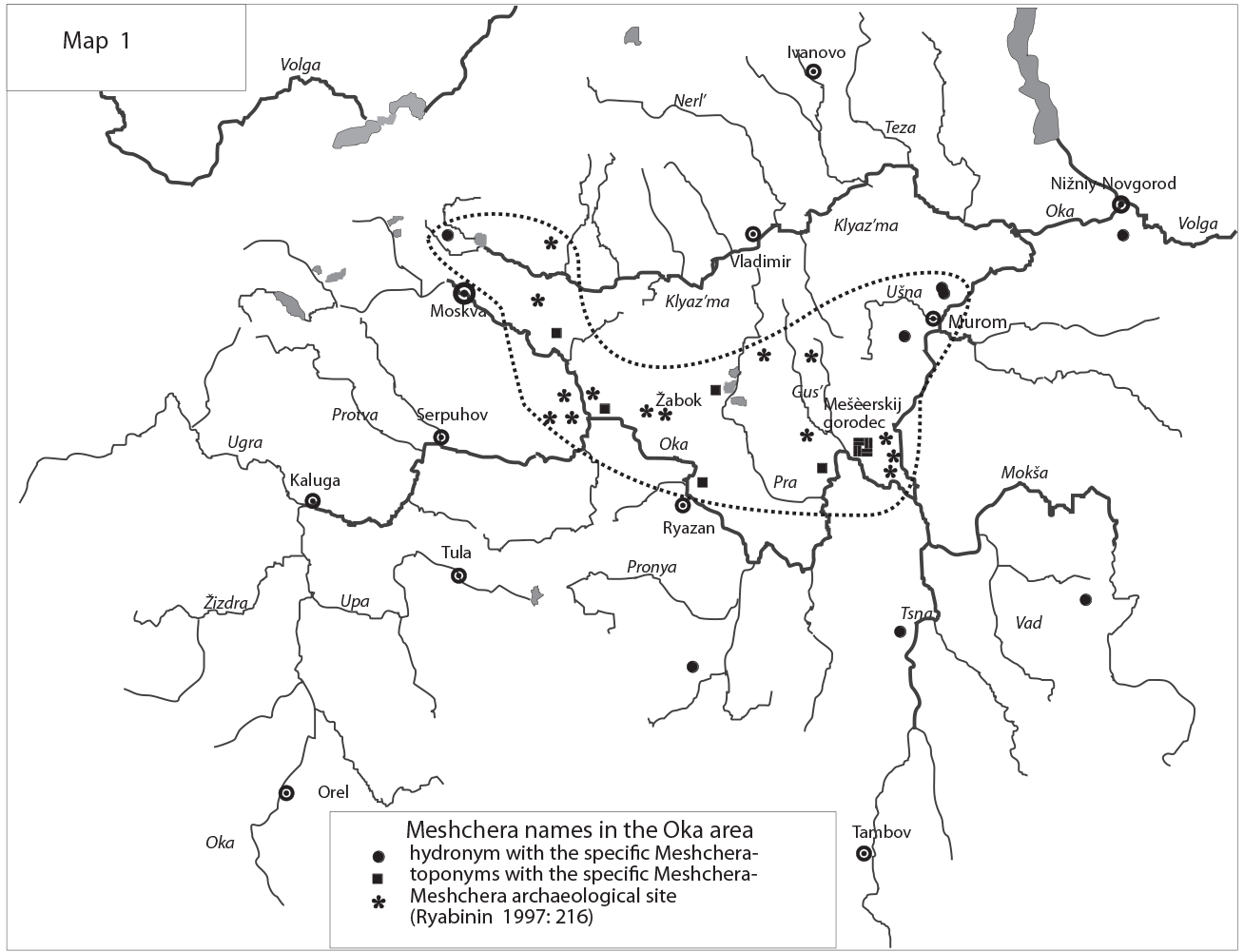
Hydrotoponymy
In particular, the areas in which the Meshcheras lived overlapped with those of the Muromas and Mordvins, exactly as stated in the Chronicle (see above). Nonetheless, we can speak of a core area of Meshcheras, which appears to have been bipolar; the more westerly territory being situated along the banks of the River Moskva and the Upper Kljaz’ma, and the eastern on the River Oka from Rjazan’ to Murom. The different approaches in this work chosen for the study of the Meshchera territories do give results that slightly differ from each other, although as a whole they are fairly congruent. Maps 4 and 6 show that the distribution of the most essential specifics vil-, ul-, un- ič- (‘upp(er), low(er), big, small’) (in the areas of Moscow, Rjazan’ and Meščerskij Gorodec) matches the archaeological sites dated 900–1200 AD fairly closely. Taking into consideration both the specifics and the evidence from archaeological excavations, the Meshcheras were located in two core areas, such that the western area was on the eastern side of Moscow and the eastern area in the Oka basin between Rjazan’ and Murom, the midpoint being Meščerskij Gorodec ~ Kasimov.
The ethnic meščёra hydronyms extend to the mouth of the Oka, which is north of Murom (maps 1 and 6). The description given by late medieval chroniclers affirming that the Meshcheras dwelt among the Mordvins and Muromas (maps 1–3) corresponds to this. The fact that these ethnic hydronyms are also found by the River Pronja, the area around the source of the Mokša, the Tambov area and in the Moscow area is also evident from the territorial distribution of the specifics vil-, ul-, un- and ič- (map 4).
The toponyms shared with Udmurtia (map 5) confirm the concept of a Meshchera territory somewhat more extensive than the archaeological findings. In addition to the territory between the Moscow area and Rjazan’- Murom, common names are attested in the area around the source of the Mokša and north of Murom in the direction of the confluence of the Oka.
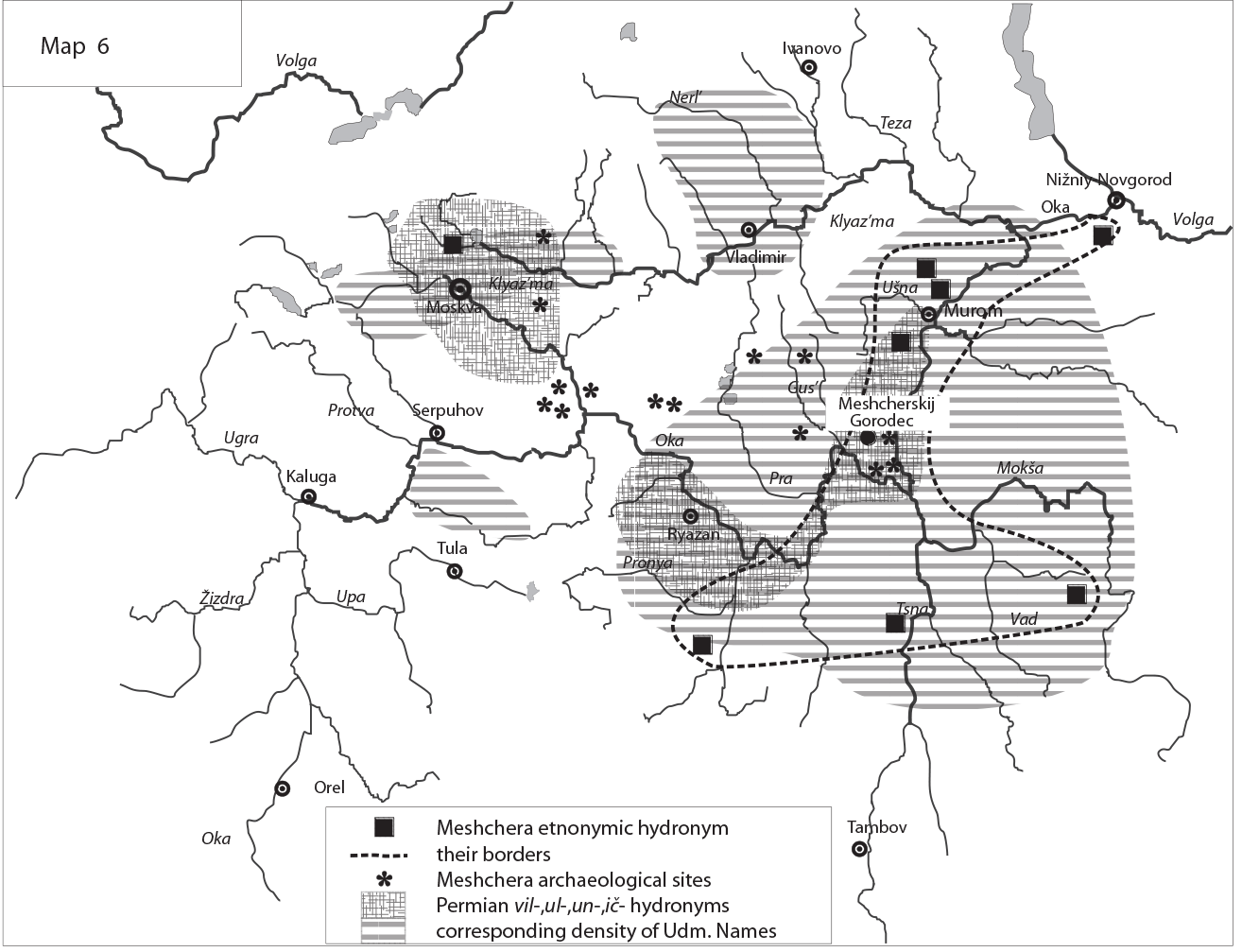
It would seem that the Permian Meshcheras tried to control the traffic on the important necks of land between the River Moskva and the Volga, between the Pronja and Don and between the Mokša and Sura. Furthermore, it would appear that they attempted to man important confluences, such as those of the Moskva, Mokša, Kljaz’ma and the Oka itself.
It should be borne in mind that Permian names also occur over a very wide territory elsewhere in central and northern Russia. Some of these are probably connected with the Anan’ino Culture fanning out from the Lower Kama towards the west. This is suggested by A. K. Matveev, who alludes to -jug names (1961, 1965). Not all of the Permian population living in the extensive area of these toponyms in northern Russia can be directly associated with the Meshcheras, but at least it would seem to apply to other different Permian groups.
In summary (map 6), it can be stated that the archaeological material provides a more limited view of the Meshcheras. The ‘big’/’little’ and ‘upper’/’lower’ names extend this territory in the direction of the lower reaches of the Oka and to the district of Rjazan’. The combined picture from the Meshchera ethnic hydronyms and the Udmurt toponyms is even more extensive than this, reaching further, particularly eastwards to the River Mokša and the north-eastern confluence region of the Oka. One explanation may be that the archaeologically defined territory corresponds to the situation 900–1200 AD, but the toponyms describe the state of affairs which, according to the chroniclers, existed at the end of the medieval period. Consequently, the Meshcheras would have moved towards the northeast and east, as suggested by Markov (1993: 3).
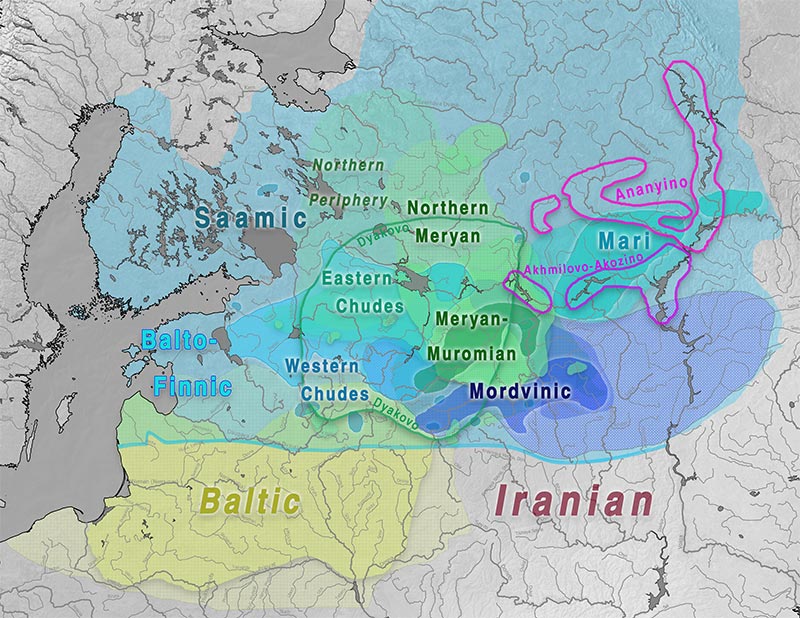
Chronology
When was this layer of Permian names established? Such an abundance of names presupposes a considerable population flow. From the archaeological point of view, there were several periods of migration. The earliest can be considered to be the period of the Anan’ino Culture ca 800–200 BC. Both A. H. Halikov and V. Patrušev consider the westward migration of the Anan’ino population in the east relatively certain (Halikov 1992: 57–60; Patrušev 2000: 89–99). The change brought about by the Anan’ino Culture in ceramics is also so striking as to suggest that an extensive migration is indeed probable. At that time Proto-Permian or, more precisely, Early Proto-Permian language was spoken (Bartens 2000: 10). On the other hand, as evidenced earlier, many archaeologists consider the Meshchera Culture to have been based on the Gorodec Culture of the Iron-Age (e.g., Rjabinin 1997: 232 and appropriate citations). As mentioned earlier, the Gorodec Culture in turn could have had contacts, at least to some extent, not only with the Anan’ino Culture, but also with that which followed, the Pjanobor–Čeganda Culture.
On the basis of what has been stated above it can be supposed that the old Permian colonies, small to begin with, lured new settlers to the productive commercial routes. Pronin speaks of “the Great Volga trading route” that proceeded from the Upper Volga to Kljaz’ma and along the River Moskva to Oka (Pronin 2006: 2). Quite possibly the connection with the old “mother land” Udmurtia continued. Linguistically this would imply a western Proto-Permian, that is, a Meshchera variant. Thus, migration could have continued over a period of almost a thousand years in the same way in which Slavic expansion occurred little by little over the course of
many centuries.
This proposal was expanded further by Rahkonen in The Western Spread of Permic Hydronyms (2014).
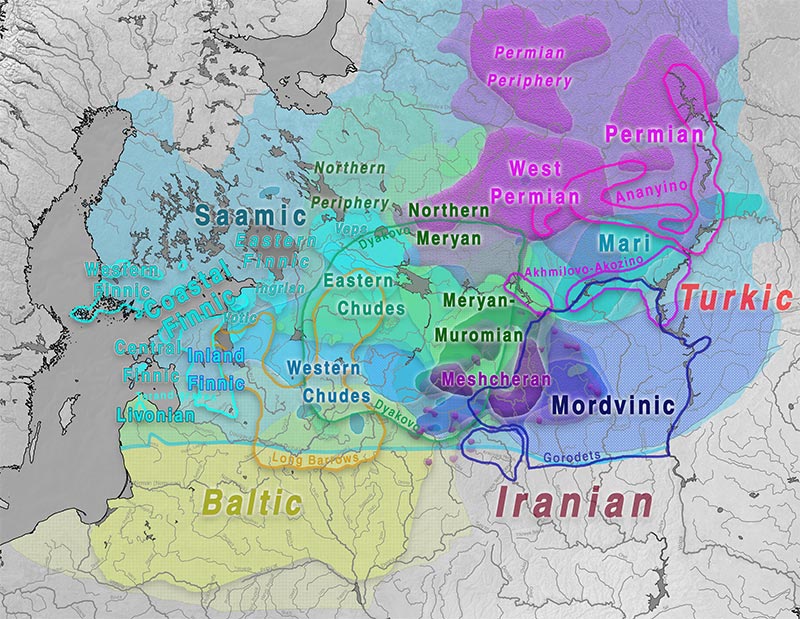
Origin of haplogroup N1a in the Baltic
The recently (re)published Vikings of hg. N scattered all over Scandinavia and lacking any substructure relative to other haplogroups reminded me of this Permian Meshchera issue that I had avoided long ago (when dealing with Germanic – Baltic – Finnic language contacts), regarding the origin of haplogroup N-CTS2929/VL29 in North-Eastern Europe.
It has become crystal clear since Saag et al. (2019) that N subclades spread into the Baltic area quite late, already assimilated to a fully Corded Ware-like ancestry, emerging during the transition of the Late Bronze Age to the Early Iron Age. It is only natural to assume that they represented initially a small proportion of incomers relative to a vast majority of Corded Ware-derived R1a-Z282-rich populations, at least in West Uralic-speaking areas.
The question remains unanswered, though: from where did those N-rich peoples infiltrate the Baltic Sea coasts, and what was their precise cultural and geographical origin?
N-CTS2929/VL29 and Akozino traders
Akozino/Akhmylovo warrior-traders are still the most evident candidates for the westward spread of hg. N-CTS2929/VL29 – N-L550 in particular – along the south-western route. Because there are no visible radical cultural changes suggestive of massive migrations in the regions where their materials are found, it must be assumed that they infiltrated all over the Baltic Sea from the Middle Volga thanks to matrimonial alliances, as proposed e.g. in Parpola (2012), during a period when a strict chiefdom system and wide-ranging personal and trade connections were being established among cultures of Northern and North-Eastern Europe, strongly influencing each other.
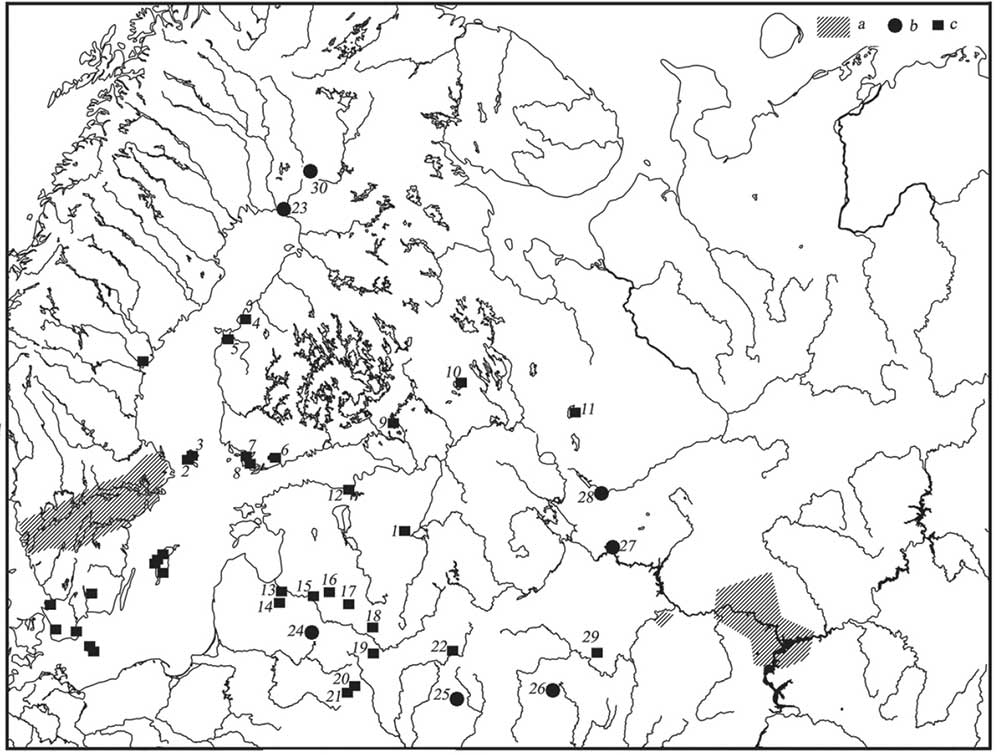
Even though interpretations of dialectal branches based on hydrotoponymy are inherently tricky and never without controversy, population genomics is clearly helping in this regard. In light of what Rahkonen (2009, 2013, 2014) proposes, my assumption based on Parpola (2012) that those Akozino migrants spoke a (Finno-)Mordvinic dialect belonging to the Volga-Finnic continuum (represented by Bronze Age territories of textile ware) might have to be revised.
It would be striking that Mordvinic-speaking Akozino migrants would have spread mainly (albeit not exclusively) with N-VL29 lines, at the same time as Mordvins – like Russians of Mordvin and Finno-Volgaic descent – maintain to this day one of the highest proportions of hg. R1a among Uralic peoples. In fact, the spread of hg. R-Z282 likely represents the eastward expansion of West Uralic- or even Finno-Permic-speaking Textile Ware groups, as the recent data on R1a-Z93-rich Fatyanovo indirectly support.
The archaic hydrotoponymic area beyond the core Meshchera archaeological region, today scattered along the most likely ancient Mälar-Akozino trading routes leading to the south and west (i.e. to the Daugava and Neman basins and beyond), seem to reinforce the theory of an early spread of Permian-speaking Akhmylovo migrants before their acculturation in far-distant regions disconnected from Permian influence, where they eventually settled down.
NOTE. Because it seems that the Meshchera must have spread east- and northward into their attested proto-historical region quite late, I think that the Gorodets culture explains better the expansion or domination of Mordvinic-speaking peoples into their proto-historical areas, rather than an expanding Meshchera population that didn’t leave any trace of river or place names in most of its territory.
This picture of genetic continuity among Mordvins, kept despite their likely multiple displacement events from west to east, seems to be paralleled by the assumed archaic nature of some morphosyntactic features of Proto-Mordvin compared to Proto-Finnic and Proto-Samic, despite the long periods under Iranian, Baltic, Turkic, or Slavic influence. This language continuity is also indirectly supported by the apparent greater dialectal variability of Finno-Permic hydrotoponymic formants around the Volga-Oka-Kama interfluves. This situation is reminiscent of the one found in ancient and modern Estonia, from where modern Finnic dialectal branches must have spread during the Iron Age – given the higher dialectal diversity of the Pskov region, Estonia, and Latvia compared to all other Finnic-speaking regions combined.
We know that N1a-CTS2929/VL29 is particularly prevalent among Lithuanians and Latvians (more than among any other ethnic group), and – based on hydrotoponymy – that Proto-Baltic peoples must have inhabited (at least) since the Early Iron Age the region around the Gulf of Gdańsk, Lithuania and Belarus. Given the predominant N1a-L550 subclades (TMRCA ca. 900 BC) of Iron Age and later samples from Estonia, Scandinavia (Oland 1099), or Lithuania (Berčiūnai 2), it is quite fitting that most modern samples from the region also fall within this subclade, based on the prevalence of Akozino materials found along this southwestern Volga-Baltic route.
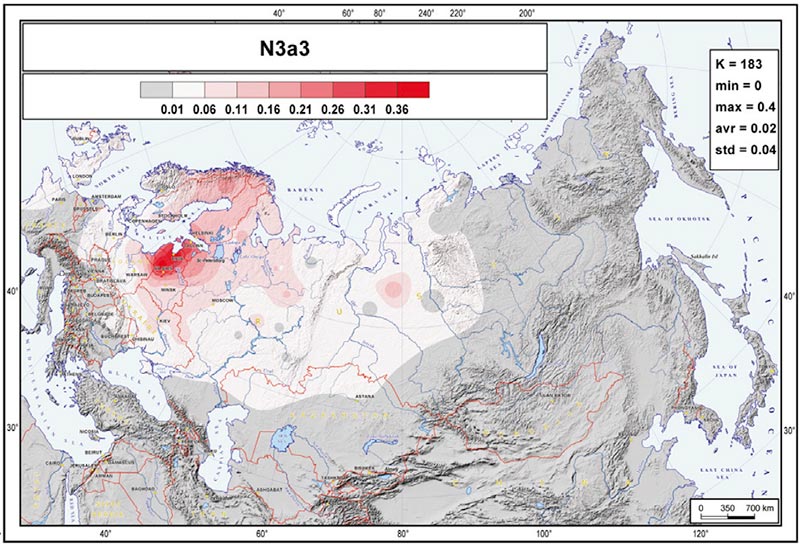
NOTE. There have been some proposals as to the potential earlier acquisition of the (fewer, ca. 100) early Baltic loans than the (ca. 500) Palaeo-Germanic ones (Junttila 2015), or due to an extinct Baltic branch being a substrate of Finnic (Kallio 2007), which could be directly related to a late spread of a N1a-rich acculturated Baltics coinciding with the split and expansion of Coastal Finnic and Livonian. Furthermore, the increase in Baltic Corded Ware-related ancestry during the Tarand-grave period and the presence of a layer of Baltic-like toponyms almost up to modern Estonia would also support this. However, I am more inclined to support the most likely a priori theoretical palaeolinguistic interpretation: that is, that the number of Germanic loans and their different chronological layers (from Pre- to Proto-Germanic apart from later loans) point to continued contacts since the Early Bronze Age, whereas the homogeneous late Balto-Slavic/early Baltic loans reflect shorter but intense contacts with an extinct dialect during the Late Bronze Age / Iron Age, before the expansion of Proto-Baltic.
The spread of N-L550 from a small regional pocket close to the Volga could also be independently proposed based only on the TMRCA estimates (ca. 1600 BC) and modern regional distribution of basal N-VL29* subclades (see YFull), which could hypothetically be ultimately linked to the expansion of Ananyino-related peoples into the early Akhmilovo-Akozino horizon, but also to contacts with Altaic- or Iranian-speaking nomads from Asia. Because the emergence and spread of the Ananyino culture is in turn strongly connected to both, (1) to populations up to the Pechora basin and the Urals, and (2) to Pre-Scythian and Scythian nomads expanding westwards into the Pontic-Caspian steppes and beyond, it is impossible to say where their N-rich populations were ultimately incorporated from, but the sampled Avars rich in sister haplogroup N-F4205 and the presence of modern VL29* samples in Kazakhstan, Samara, and Croatia still suggest the latter, as does the ancient phylogeographic picture of hg. N available today.
N-Z1936 and Ananyino traders?
The fact that Iron Age and Early Medieval South-West Finns will also show N-VL29 subclades together with an overwhelming Corded Ware-related ancestry in common with Northern Slavs suggests that the spread of the typical Finnish N-Z1936 subclades to Fennoscandia must have been part of different, much later admixture events. It remains unclear whether its spread was originally also related to Ananyino or Akozino (through a northern trading route) or to other unrelated cultural expansions, such as those linked to northern Fennoscandian Proto-European- or Palaeo-Laplandic-speaking asbestos ware groups.
Basal N-L1026* subclades (already attested in Bronze Age individuals from the Lovozero culture) are present among modern populations from Finland and Scandinavia, and basal subclades are also prevalent among modern Udmurts – with completely different proportions found in different Komi samplings and among Maris. All this might suggest that the expansion of genetically admixed Ananyino-related peoples is the cause for this variety of haplogroup N around the Middle and Upper Volga, and also eventually throughout Fennoscandia, too, given the late (and obscured) linguistic and genetic mixture events of Western and Eastern Finnic speakers, and the acculturation of Iron Age Saami under Finnic, and of non-Uralic speakers under Samic further north.
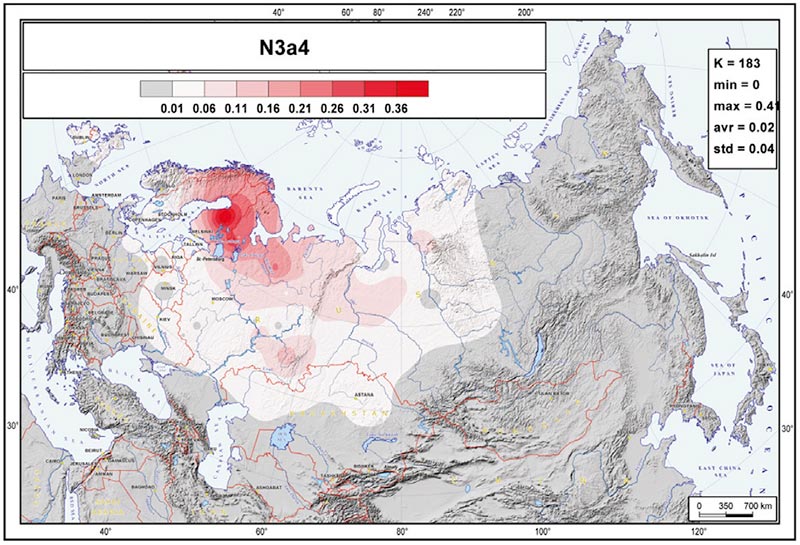
The potentially Proto-Permic *-jug(a) hydronyms (distinct from the Muroma jug(a)), especially prevalent in the so-called “West Permian” linguistic area, support a northern route quite likely associated with the expansion of Proto-Permians from Ananyino, as proposed originally by Matveev (1965) and contra Matveev’s (2001:254) later opinion that they are of unknown FU origin, and Rahkonen’s (2014) opinion that “the specifics connected with the generic -jug seem to be in many cases too recent”. It is generally agreed that *juka ‘river’ shows a different evolution in Common Permian, as shown by Komi/Udmurt ju, but modern hydronyms of Komi territory with -ju still had the form -juga in the 15th-17th centuries (Matveev 2001:255), and the Proto-Permic form based on Udmurt relies solely on a compound word ju-šur (see full discussion in Rahkonen 2014).
The presence of Permian-speaking peoples in the area surviving up to the Middle Ages is also supported indirectly by the Uralic (mostly Finnic and to a lesser extent Permian) substrate interference in the vocabulary and some features of prosody and morphosyntax of Northern Russian dialects (e.g. in Veenker 1967, Vostrikov 1990, Sarhimaa 1995, Saarikivi 2000), suggesting that the Novgorodian Rus’ developed over a mainly Finnic- and Permian-speaking population. This is now supported also in genetics by Zhernakova et al. (2019), which shows that Northern Russians have a predominantly Finno-Permic genetic stock.
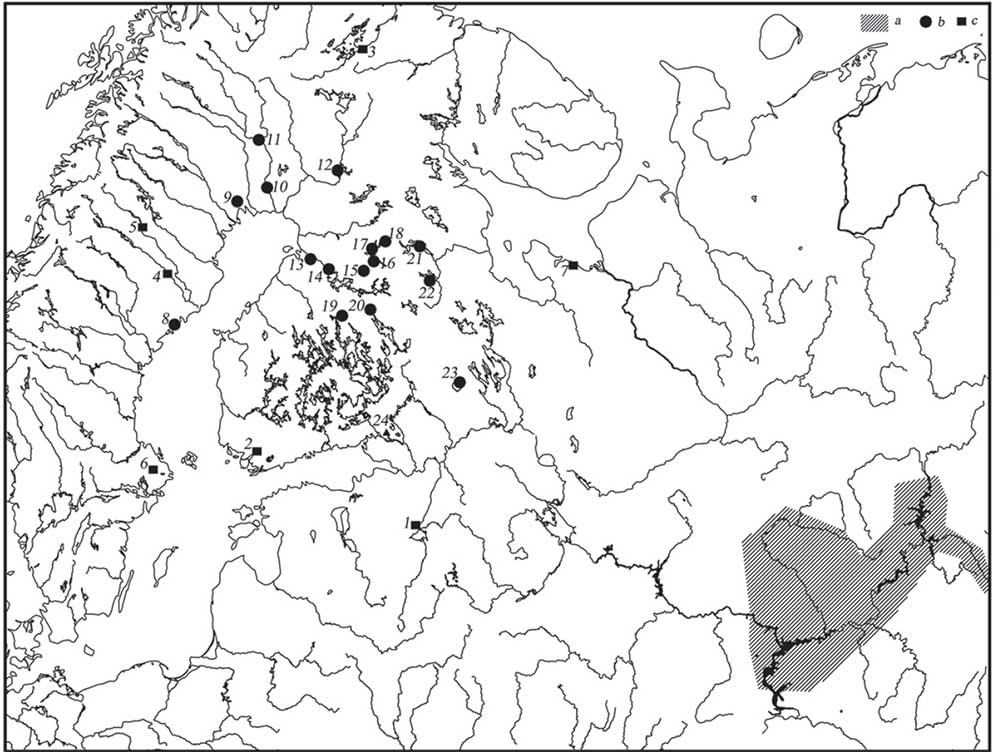
The recent publication of Kushnarenkovo-related medieval individuals from the Uyelgi site might suggest that a very specific N-Z1936 subclade (also associated with some Hungarian conqueror lineages) spread from South-West Siberia to the Cis-Urals quite late, possibly coinciding with strong cultural and genetic influences from Iranian and Turkic peoples in the region (and potentially that of Volga Bulgars before them). However, the sampling is focused on a single site and offers a mere glimpse of a quite late period.
The comparatively weaker hydrotoponymic stance and scarce proto-linguistic support for the “West Permian” proposal, as well as the lack of intermediate Ananyino-related materials to depict clear northern routes of expansion of Proto-Permic speakers is discouraging. Assuming the same northern route as for Akozino-Mälar materials, together with ancient DNA samples from the region, might eventually clarify the genetic picture of the Early Iron Age Cis-Urals, and maybe also indirectly whether an Iron Age northward expansion of N-Z1936-rich populations makes sense or not.
That chronological and regional uncertainty is then still compatible with proposals involving Seima-Turbino, Netted Ware, Ananyino, or even later population movements, including incoming nomads from the eastern steppes, although Permian-speaking groups (and thus Ananyino-related groups) seem to be key in any process involving the infiltration of N1a among Finno-Permians. Based on the modern distribution of haplogroup N, I’d still bet in general terms for an early expansion of N-1026* and N-Z1936 among Bronze Age populations on both sides of the (northern) Urals; see e.g. related discussions on Mordvins & Mari-Permians and on Baltic Finns & Saami.
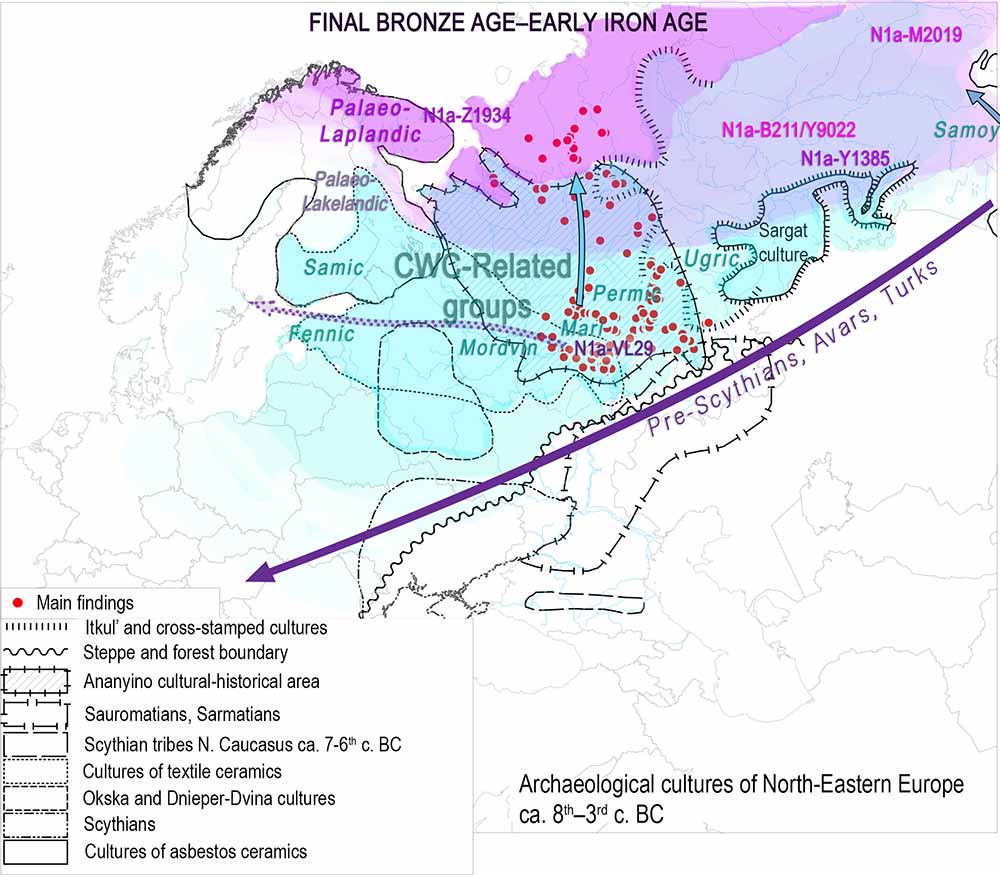
Relevance for the Uralic homeland
All in all, it is still unclear how the different subclades of haplogroup N1a present today in Europe reached the Cis-Urals and then further west. There is, of course, no connection between the expansion of Finno-Mordvinic and either haplogroup N or “Siberian” ancestry (which geneticists have shown to be a meaningless portmanteau for anything other than “Steppe” ancestry), and even less so with the considerably earlier expansion of archaic Uralic branches. Proto-Uralic is deemed to have already split up (and be physically separated) into its known dialects from ca. 4000 BC in traditional estimates, and no later than ca. 2500-2000 BC in more recent ones, so Early Iron Age cultures can only fit with a proto-language stage.
Despite the uncertainties concerning both concepts, haplogroup N and “Siberian” ancestry, they still constitute the overly simplistic pillars of many geneticists who deal with the Uralic homeland question, which compels them to twist palaeolinguistics into weird and often hilariously contradictory ideas after each new genetic report, very likely to influence in turn what linguists might assert in the future, in a vicious circle of constantly upending theoretically correct linguistic interpretations to assume whatever fits certain preconceptions. We are already seeing this among Indo-Europeanists, with some attempts at reviving 19th century theories crushed by genetic finds only to beget even wilder ones – like the racial idea of eternal Balto-Slavic forest hunter-gatherers continuing the Fatyanovo culture obliterated by a recent sampling, that will probably ignite an even crazier idea of tundra-forest Indo-Iranian charioteers, which I already showed was predictable two years ago.
Based on modern phylogeography and TMRCA estimations, anyone could have assumed that the expansion of haplogroup N-L718 happened on both sides of the Urals well before the expansion of Corded Ware, likely associated with Comb Ware groups. Due to the available simplistic models of expansion of archaeological cultures, and to early and likely erroneous reports of Y-DNA from North-East Europe, it was reasonable until about 2015 to accept that N1a-rich EHG populations like Volosovo could have admixed with R1a-rich Steppe-related Corded Ware individuals rather early, either lending or borrowing their language before their admixed offshoots expanded further through the Forest Zone and beyond the Urals.
We have known for a while why this reasoning was essentially flawed: it relied mainly on data from confounders; modern Finnish or Slavic cohorts that are but another reflection of the Basque problem: too much focus on one overtested region and a catastrophic chain of simplistic assumptions about its population. Basques and Finns turned out not to be a model of continuity and diversity in terms of Y-DNA haplogroups (just as they weren’t in cultural or regional terms of their respective proto-languages), but rather the complete opposite: they are the best models we currently have of how recent DNA bottlenecks and radical founder effects work when coupled with recent language expansions – and how they can help distort the original palaeolinguistic and archaeogenetic picture.
See also
- Tug of war between Balto-Slavic and West Uralic (II)
- European hydrotoponymy (IV): tug of war between Balto-Slavic and West Uralic
- Genetic continuity among Uralic-speaking cultures in north-eastern Europe
- The cradle of Russians, an obvious Finno-Volgaic genetic hotspot
- Pre-Germanic and Pre-Balto-Finnic shared vocabulary from Pitted Ware seal hunters
- De-Neolithisation of Corded Ware groups in the Eastern Baltic
- Volosovo hunter-gatherers started to disappear earlier than previously believed
- Corded Ware ancestry in North Eurasia and the Uralic expansion
- Uralic speakers formed clines of Corded Ware ancestry with WHG:ANE populations
- Balto-Slavic accentual mobility: an innovation in contact with Balto-Finnic